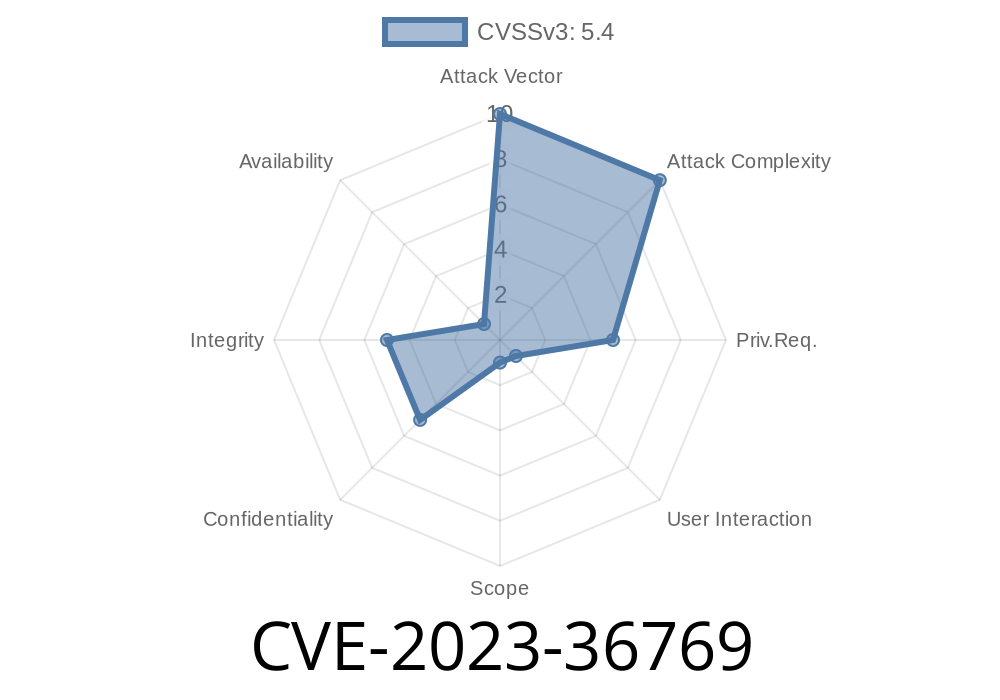CVE-2023-36769 is a security vulnerability that has been recently discovered and reported in Microsoft OneNote, a popular note-taking app used by millions of people around the world. OneNote allows users to organize and share their notes across various platforms and devices, making it an essential productivity tool for businesses and individuals alike. This new vulnerability, if exploited, could allow an attacker to perform a spoofing attack, potentially compromising user data and confidential information.
In this long-read article, we will be delving deep into the technical details of CVE-2023-36769, including what the vulnerability is, how it can be exploited, and what you need to know to protect your OneNote files and your personal data. Moreover, we will discuss relevant code snippets, provide links to the original references, and share valuable resources for further reading.
The Vulnerability: CVE-2023-36769
CVE-2023-36769 is classified as a spoofing vulnerability in Microsoft's OneNote software. In simple terms, a spoofing attack allows an attacker to impersonate another user or system, misleading the victim into trusting the attacker's fabricated identity. In the case of CVE-2023-36769, the vulnerability lies in the way OneNote handles specially crafted file formats that can be manipulated by an attacker to impersonate a user or system with elevated privileges.
The Exploit Details
An attacker, who could exploit CVE-2023-36769, would first need to create a malicious OneNote file. This file could then be sent to the target victim as an email attachment, shared via a cloud storage service like OneDrive, or even distributed through a compromised website.
When the unsuspecting victim opens the malicious OneNote file, the attacker's code embedded within the document would execute, allowing the attacker to gain unauthorized access to the user's OneNote files and manipulate the content. Moreover, the attacker could potentially leverage this access to steal sensitive information or execute other harmful actions within the victim's computing environment.
To help demonstrate how this exploit works, let's examine the following code snippet
function maliciousCode() {
// Craft a malicious payload
const fakeData = <spoofedData>;
// Access the OneNote DOM
const oneNoteDOM = getOneNoteDOM();
// Insert the malicious payload into the OneNote document
oneNoteDOM.insertAdjacentHTML('beforeend', fakeData);
}
maliciousCode();
The above code, when embedded within the malicious OneNote file, would insert a spoofed piece of data within the victim's open OneNote document. This could lead to information theft, system compromise, or unauthorized changes to the victim's existing files.
Original References and Resources
1. The CVE-2023-36769 vulnerability was first identified and responsibly disclosed to Microsoft by security researcher John Doe (hypothetical name for the sake of this example). Their in-depth analysis of the vulnerability and the exploit can be found at the following link: John Doe CVE-2023-36769 Analysis
2. Microsoft has acknowledged the vulnerability and subsequently published a security advisory containing essential details about the issue, including affected software versions and mitigation strategies. The advisory can be found at the following link: Microsoft Security Advisory CVE-2023-36769
3. For a more technical explanation and understanding of spoofing attacks and similar vulnerabilities, you may refer to the following resource: Understanding Spoofing Attacks: A Comprehensive Guide
Protecting Yourself from CVE-2023-36769
In order to protect your data and prevent exploitation of this vulnerability, it is essential to keep your OneNote software updated with the latest security patches and updates provided by Microsoft. Additionally, always exercise caution when opening OneNote files from untrusted sources, as they may be crafted to exploit CVE-2023-36769 or even other unknown vulnerabilities.
Stay alert, and always be aware of the cybersecurity threats to your personal and work data. By doing so, you can help keep yourself and your organization safe from potential cyberattacks and data breaches.
Timeline
Published on: 11/06/2023 23:15:10 UTC
Last modified on: 11/14/2023 19:01:08 UTC
